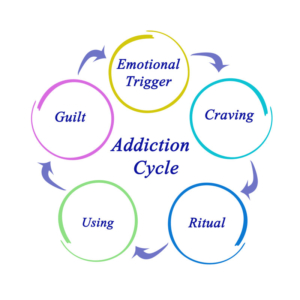Addiction can be of two sorts. The first is substance dependence where an individual relies on the use of a psychoactive substance to seek relief of some sort, such as drugs or alcohol. The second is behavioral addiction where a there is a psychological dependency on a behavior such as gambling or sex to feel better.
In either scenario, substance addiction or the addictive behavior become something that cannot be controlled by the individual, and they become dependent on it to cope with daily life.
 Common risk factors
Common risk factors
Risk factors that can put people at a higher possibility for substance dependency can include the following:
- Loneliness is a major factor for people who spend too much time by themselves and may turn to substance abuse as a coping mechanism.
- Peer pressure is another risk factor as individuals try to conform to other members of a group and gain acceptance.
- Family behavior could also be a possible cause for individuals who do not share a strong attachment to their parents or siblings.
- Mental illnesses such as ADHD, depression or others may turn an individual towards substance dependency for better dealing with everyday life.
- Stress is an active participant in addiction as high levels of stress can elevate the chance of substance abuse. Plus stress hormones also respond to substances like alcohol and drugs.
The role of the brain
When the use of certain substances goes beyond the control of the user, changes in the brain occur which promote this continued use.
- Tolerance increases– after some time the addict does not get the same pleasure from an addictive substance and needs to increase their dose as the body’s tolerance to the substance increases.
- Withdrawal symptoms– when the substance no longer gives pleasure to the user, the individual may continue using it just to prevent withdrawal symptoms.
With heightened tolerance comes the greater risk of addiction.
Seeking treatment with alternative drug rehab
- Conventional treatment focuses on psychotherapy where one-on-one, or family group sessions are administered. Sessions aim to offer help with coping with cravings and dealing with possible relapses.
- Self-help groups assist the patient in meeting other individuals with the same problem. The groups work to boost motivation along with offering education and information. It may also help to keep an addiction journal to monitor progress.
What can neuroscience offer?
Some newer approaches to treating addiction include the following options:
- Transcranial magnetic stimulation (TMS) This approach uses magnetic fields to strategically stimulate parts of the brain. The prefrontal cortex or the part of the brain that helps people to not act on every impulse is stimulated so that individuals may be better able to suppress the insatiable urge to take an addictive substance.
TMS is not new to medicine and is already an approved therapy for depression. However, its application in treating drug addiction is moving into new territory.
- Kappa opioid receptor antagonists are compounds that can help prevent drug withdrawal by causing low dopamine levels. Currently, there are different ongoing clinical trials testing these compounds for treating addiction.
